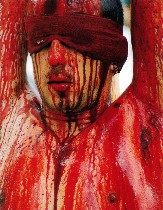Post by Colette Copeland

nitsch, hermann
I took my visual studies class to see the Hermann Nitsch retrospective at Slought Gallery this week, “Hermann Nitsch / Die Aktionen: 1962-2003” (right, Hermann Nitsch, “Das Orgien Mysterien Theater / Theater of Orgies and Mysteries,” Salzburg, 1990) .
These are bright, well-read, open-minded students. Two of them refused to even enter the gallery. Quite a few were repulsed and shocked. Director Aaron Levy graciously turned off all the video monitors, so that the class could engage in a conversation.
We spoke at length about the work in terms of its historical, political, geographical, psychological and social context. We spoke about Nitsch’s legacy and influence on contemporary performance artists. Despite all attempts, the class was unable to get beyond the immediate visceral reaction to the subject matter. Levy told me that everyone has that experience at first, and after awhile, I would get over it. Well, my feeling of nausea only intensified after an hour of viewing the work.
My epiphany came on Tuesday night, when Spiegel fellow Paul Chan lectured at Penn. He stated that he wants art that ‘breaks’ him. In his own work, he strives to dismantle ideas and recontextualize meaning, so that his art can breathe, live, exist, confuse and provoke.
Those ideas are the conduit to Nitsch’s work. I don’t buy that Nitsch’s work is apolitical or that it is about releasing the ego. The ritualized sacrificial acts involving animal slaughter, crucifixion and lots of blood reverberate on many levels, which is why they are so disturbing. My feminist nature is horrified at witnessing the naked, seemingly vulnerable women blindfolded and splayed on the cross. However, it is important to note that all performers are willing participants and the performances do not contain any violence towards humans.
In keeping with Chan’s motto of art that ‘breaks’ him, Nitsch’s work succeeds on that level. Nitsch’s performances rupture the status quo. They are mythic, referencing Greek theater, early Roman Christian executions and Mayan games. The performances are Wagnerian in scale and duration. The spectacle, with its complicated relationship to audience and participants, undermines traditional notions of what constitutes a ‘civilized’ society. Because Nitsch is such an extremist, he paved the way for artists like Chris Burden, Andres Serrano, Damien Hirst and Joel Peter Witkin (That is not to say that he directly influenced them–but their work does not seem so extreme in comparison to Nitsch). Bravo for Slought for having the courage to exhibit such controversial work.
[For another take on Nitsch, read Roberta’s article in the Weekly. Also, Ed Sozanski in today’s Inky wrote about him (you can try using artblog’s ids–name, lrrf; email, libby@rosof.org; password, lrrfartblog).]
–Video artist Colette Copeland is a regular artblog contributor









